How NDOT mistakes forced taxpayers to pay twice for tortoise fence




The flawed installation of fences intended to protect the Mojave Desert Tortoise from highway traffic cost taxpayers more than $700,000 to correct, and faulty culvert drainage killed one of the protected animals, a Las Vegas Review-Journal investigation found.
The Nevada Department of Transportation approved a $529,000 bid to install the fencing along U.S. Highway 95 in 2015. Taxpayers paid an additional $736,000 to fix the 37 miles of fencing after U.S. Fish and Wildlife inspectors found the barrier did not meet federal standards, records show.
And drainage for culverts that allow the reptiles to move under the freeway was so poorly designed that one of the threatened animals became trapped in the boulders and died, documents show.
Taxpayers spent as much as $320,000 for tortoise passageways and rocks around culverts, bidding records show. The state is working on a fix with federal officials. It is not clear how much the repairs will cost or when it will be completed.
The Federal Highway Administration, which paid for the repaving between Indian Springs and Mercury, blocked the state from using federal funds to fix the fence.
“They made a mistake and federal taxpayers shouldn’t be on the hook for that,” said agency spokesman Doug Hecox, adding that state dollars paid to fix the problem.
Highway administration engineer Iyad Alattar criticized NDOT biologists and monitors on the project because they were supposed to catch problems with the tortoise protection measures, emails show. 
‘A learning process’
NDOT spokesman Tony Illia conceded state workers made a mistake but said the fence replacement was only about 3 percent of the initial $22 million cost of resurfacing the stretch of U.S. 95.
“This was a learning process for us,” he said. “The project didn’t run over budget because we had a contingency for just such a situation.”
Roy Averill-Murray, the desert tortoise recovery coordinator for the U.S. Fish and Wildlife Service in Reno, said the NDOT mistakes are surprising because federal guidelines are clear.
“We have pretty widely known and widely distributed fencing specifications,” he said. “Those fencing specs are used fairly often and are not confusing.”
Federal regulations require a 36-inch fence measuring 12 inches underground and 24 inches above ground. But U.S. Fish and Wildlife officials found that NDOT contractors used fencing that was a total of only 24 inches tall, records show. Inspections showed that as a result, the barrier in some places was as low as 8 inches above ground. In other places, the fencing below ground measured 4 to 6 inches or less, which the federal agency called “unacceptable” in a letter to NDOT.
State records show that NDOT engineers had federal manuals that outlined the fence requirements.
“Tortoise exclusionary fencing that is properly constructed and maintained is an important conservation tool and has likely saved the lives of countless tortoises and other wildlife along highways that would otherwise be struck by high-speed vehicles,” Fish and Wildlife staff wrote.
NDOT built about 290 of the nearly 400 miles of tortoise fence in Clark County, transportation officials said. Glen Knowles , the U.S. Fish and Wildlife supervisor in Las Vegas, said the agency does not have enough staff to inspect all the fences but found problems on U.S. 95 because they were in the area for a site visit.
The Mojave Desert Tortoise has a declining population of only about 200,000 and was put on the federal threatened species list in 1990. The culverts are supposed to allow the tortoises to safely move across highways, ensuring mating and diversity of the species. 
‘Some miscommunication’
U.S. Fish and Wildlife’s Averill-Murray said state and federal officials did not come up with a good design for the culverts.
“It’s fair to say there was some miscommunication along the way,” he said.
Of the 10 culverts designed for tortoises on the project, all but one will require at least some repairs, according to a May 10, 2017, letter from Fish and Wildlife to the state’s environmental services division.
“Pooling of water in deep plunge-pool could attract tortoises that might either become trapped in the (boulders) or suffer drowning,” federal inspectors wrote.
Federal officials sometimes allow for unintentional deaths — even for threatened species — if the project is extensive enough to raise the risk of harm. But Knowles said transportation officials did not have approval for any incidental tortoise deaths on the project.
Even so, the state is not likely to face fines.
“In extreme negligence cases we might impose civil penalties, but we typically find they make a good-faith effort to avoid any deaths,” he said.
NDOT spokesman Illia said the state will work more closely with federal officials to ensure the projects are done properly the first time.
“We’re not really focused on laying blame,” Illia said. “We’re assuming responsibility.”
Contact Arthur Kane at akane@reviewjournal.com. Follow @ArthurMKane on Twitter.













